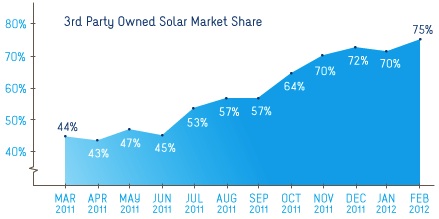A typical 3kWp (kilo Watt-peak) solar system, which produces about 2 500 kWh of electricity annually, or the equivalent of two thirds of a typical American household`s consumption, will end up around $15 000. There is no doubt that purchasing solar panels turn off a lot of homeowners because of the high upfront costs and home insurance. In the last couple of years things have changed the situation for the better – Smart and creative financing models have been put in place to make solar power more affordable for Average Joe.
According to PV Solar Report, more than three out of four Californians prefer third-party-owned solar, which also happens to be the market share as of February 2012:
The same trend can be seen across the rest of the country as well – and it keeps growing. What are the different third-party-owned financing models that are available?
Leasing and Power Purchase Agreements (PPAs)
Leasing solar systems is the obvious one. Your solar distributor most likely offers removing most, if not all, of the upfront costs of the entire solar system. The only thing that is required from you is a suitable place to put the solar panels. This could be on the top of your roof or on a pivoting stand in the yard – it doesn’t really matter as long as there are no issues with shading, cardinal direction, and limited solar insolation.
The solar company owns the solar system, and is responsible for monitoring, maintenance and repairs. You pay a fixed monthly amount to the solar company, independent of how much electricity the solar panels output, and have the rights to utilize this electricity (whether it be purely for own consumption or “sell” the excess with net metering).
Power purchase agreements (PPAs) are very similar. The only significant difference is the way you pay the solar company: Instead of paying a fixed monthly amount for the solar system, you pay for the amount electricity they produce (per kWh).
Community-Owned Solar
We are also seeing growth in community-owned solar. Instead of having to position the solar system on top of the roof, the homeowner can now subscribe to a community-owned “solar garden”, which enables them to generate clean electricity without having photovoltaics on their own property.
In fact, most people in America are not suitable for solar. Imagine how much the domestic solar market will expand, as increasing numbers will be offered a membership at the local solar farm, regardless of whether or not their own property is suitable for solar power.
There are several ways a solar garden could be structured. Today`s solar gardens are either ran and owned by the solar distributor, the utility, an individual company or even the homeowners themselves (if virtual net metering is in place).
Either with leasing, PPAs or community-owned solar, the homeowner should comes out profiting from their investment – the foundation for growth in the industry. Which one is best for you is an entirely different question, one that is highly dependent on where you live and most importantly, the financial incentives and programs your state has in place.
Guest article by Mathias Aarre Maehlum. He studies energy and environmental engineering, works in the solar panel industry, and in his spare time he writes about solar panel costs at EnergyInformative.org.
